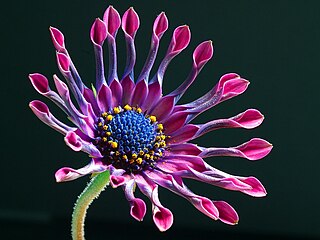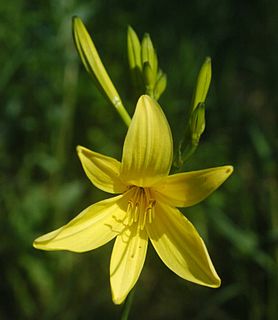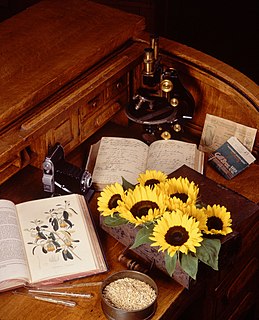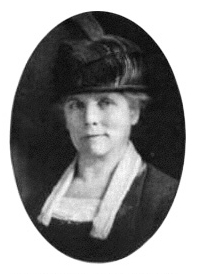Related Research Articles

Iris is a genus of 260–300 species of flowering plants with showy flowers. It takes its name from the Greek word for a rainbow, which is also the name for the Greek goddess of the rainbow, Iris. Some authors state that the name refers to the wide variety of flower colors found among the many species. As well as being the scientific name, iris is also widely used as a common name for all Iris species, as well as some belonging to other closely related genera. A common name for some species is 'flags', while the plants of the subgenus Scorpiris are widely known as 'junos', particularly in horticulture. It is a popular garden flower.

A cultivar is a type of plant that people have bred for desired traits, which are reproduced in each new generation by a method such as grafting, tissue culture or carefully controlled seed production. Most cultivars arise from purposeful human manipulation, but some originate from wild plants that have distinctive characteristics. Cultivar names are chosen according to rules of the International Code of Nomenclature for Cultivated Plants (ICNCP), and not all cultivated plants qualify as cultivars. Horticulturists generally believe the word cultivar was coined as a term which means "cultivated variety".

A daylily or day lily is a flowering plant in the genus Hemerocallis, a member of the family Asphodelaceae, subfamily Hemerocallidoideae. Despite the common name, it is not in fact a lily. Gardening enthusiasts and horticulturists have long bred daylily species for their attractive flowers. Thousands of cultivars have been registered by local and international Hemerocallis societies.

The New York Botanical Garden (NYBG) is a botanical garden at Bronx Park in the Bronx, New York City. Established in 1891, it is located on a 250-acre (100 ha) site that contains a landscape with over one million living plants; the Enid A. Haupt Conservatory, a greenhouse containing several habitats; and the LuEsther T. Mertz Library, which contains one of the world's largest collections of botany-related texts. As of 2016, over a million people visit the New York Botanical Garden annually.

The peony or paeony is a flowering plant in the genus Paeonia, the only genus in the family Paeoniaceae. Peonies are native to Asia, Europe and Western North America. Scientists differ on the number of species that can be distinguished, ranging from 25 to 40, although the current consensus is 33 known species. The relationships between the species need to be further clarified.
The Mizzou Botanic Garden contains thousands of plants within the campus of the University of Missouri in Columbia, Missouri, United States. The Garden includes famous icons, such as Thomas Jefferson's original grave marker and the Columns of Academic Hall, and is open year-round, only asking for a small donation to visit.

Symphyotrichum lateriflorum is a species of flowering plant in the aster family (Asteraceae). Commonly known as calico aster, starved aster, and white woodland aster, it is native to eastern and central North America. It is a perennial and herbaceous plant that may reach heights up to 120 centimeters and widths up to 30 cm (1 ft).

Cultivated plant taxonomy is the study of the theory and practice of the science that identifies, describes, classifies, and names cultigens—those plants whose origin or selection is primarily due to intentional human activity. Cultivated plant taxonomists do, however, work with all kinds of plants in cultivation.
John Caspar Wister was one of the United States' most highly honored horticulturists.

Elizabeth Gertrude Britton was an American botanist, bryologist, and educator. She and her husband, Nathaniel Lord Britton played a significant role in the fundraising and creation of the New York Botanical Garden. She was a co-founder of the predecessor to the American Bryological and Lichenological Society. She was an activist for protection of wildflowers, inspiring local chapter activities and the passage of legislation. Elizabeth Britton made major contributions to the literature of mosses, publishing 170 papers in that field.
John Hendley Barnhart was an American botanist and author, specializing in biographies of botanists.
James Marion Shull (1872–1948) was an American botanist known for his iris and daylily cultivars and botanical illustrations.
William Rickatson Dykes was an English amateur botanist who became an expert in the field of iris breeding and wrote several influential books on the subject. He was also interested in tulips, amaryllis, and other plants.

Lowell Fitz Randolph was an American scientist, in the field of genetics, botany and horticulture. He was a Cornell University graduate who became Professor of Botany and was also employed as an associate cytologist for the United States Department of Agriculture. He was also an avid iris collector and wrote a book on the Iris genus. He carried out important research into plant chromosomes of iris, orchid genus and corn plants. He was sometimes known as "Fitz" by his many friends and associates.

Grace Sturtevant (1865–1947) was an early 20th century iris breeder who has been called "America's first lady of iris". She was a founding member of the American Iris Society.
Ethel Anson (Steel) Peckham (1879–1965) was an American horticulturist and botanical artist who bred plants that grow from bulbs and rhizomes such as iris and daffodil. She was a founding member and early director of the American Iris Society (AIS), editor of its first major checklists, and author of its iris-judging rules. She bred iris herself and is credited with helping to introduce a new class, the miniature tall bearded iris. She is one of only a dozen people to have received the AIS Gold Medal, the society's highest honor, and she was also awarded the Gold Medal of the British Iris Society for her paintings of iris.
Mary Helen Wingate Lloyd (1868–1934) was an American horticulturist who was a founding member of the American Iris Society and creator of a celebrated "iris bowl" garden.
Arthur John "A.J." Bliss (1862–1931) was a British iris breeder who is credited with greatly improving the genetics of many modern strains, especially those descending from his Dominion cultivar.
Robert Sturtevant (1892–1955) was an American landscape architect and iris breeder. He taught for many years at the Lowthorpe School of Landscape Architecture, and he helped to found the American Iris Society.
Sir Frederick Claude Stern was a botanist and horticulturalist, known for developing the gardens at Highdown, for creating several cultivars of garden plants and for his publications on peonies, snowdrops and gardening. He also tried to promote the interests of the Jewish community.
References
- 1 2 3 4 Whitehead, Anner M. "Founding of the AIS: A New York Story". American Iris Society website. Accessed Dec. 20, 2015.
- 1 2 3 4 "Records of the American Iris Society (RA)". Mertz Library, New York Botanical Garden website, 2005. Accessed Dec. 20, 2015.
- ↑ Whitehead, Anner M. "The Origins of the American Iris Society Check Lists". American Iris Society website. Accessed Dec. 20, 2015.
- ↑ "F.A.Q." AIS Foundation website. Accessed Dec. 20, 2015.
- ↑ "AIS Awards". American Iris Society website. Accessed May 24, 2020.